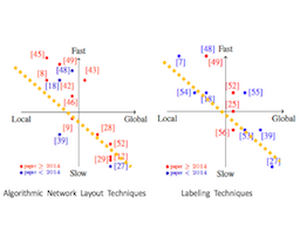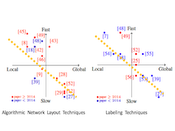Information
- Publication Type: WorkshopTalk
- Workgroup(s)/Project(s):
- Date: 11. April 2019
- Call for Papers: Call for Paper
- DOI: https://www.ac.tuwien.ac.at/files/pub/smw19-position-5.pdf
- Event: The 2nd Schematic Mapping Workshop 2019
- Lecturer: Hsiang-Yun Wu
- Location: Vienna, Austria
- Keywords: Metro Maps, Graph Drawing, Metaphors
Abstract
Schematic maps are in daily use to show the connec- tivity of subway systems and to facilitate travellers to plan their journeys effectively. This study surveys up-to-date algorithmic approaches in order to give an overview of the state of the art in schematic network mapping. The study investigates the hypothesis that the choice of algorithmic approach is often guided by the requirements of the mapping application. For example, an algorithm that computes globally optimal solutions for schematic maps is capable of producing results for printing, while it is not suitable for computing instant layouts due to its long running time. Our analysis and discussion, therefore, focus on the compu- tational complexity of the problem formulation and the running times of the schematic map algorithms, including algorithmic network layout techniques and station labeling techniques. The correlation between problem complexity and running time is then visually depicted using scatter plot diagrams. Moreover, since metro maps are common metaphors for data visualization, we also investigate online tools and application domains using metro map representations for analytics purposes, and finally summarize the potential future opportunities for schematic maps.Additional Files and Images
Weblinks
BibTeX
@WorkshopTalk{wu-2019-smw,
title = " A Survey on Computing Schematic Network Maps: The Challenge
to Interactivity",
author = "Hsiang-Yun Wu and Benjamin Niedermann and Shigeo Takahashi
and Martin N\"{o}llenburg",
year = "2019",
abstract = "Schematic maps are in daily use to show the connec- tivity
of subway systems and to facilitate travellers to plan their
journeys effectively. This study surveys up-to-date
algorithmic approaches in order to give an overview of the
state of the art in schematic network mapping. The study
investigates the hypothesis that the choice of algorithmic
approach is often guided by the requirements of the mapping
application. For example, an algorithm that computes
globally optimal solutions for schematic maps is capable of
producing results for printing, while it is not suitable for
computing instant layouts due to its long running time. Our
analysis and discussion, therefore, focus on the compu-
tational complexity of the problem formulation and the
running times of the schematic map algorithms, including
algorithmic network layout techniques and station labeling
techniques. The correlation between problem complexity and
running time is then visually depicted using scatter plot
diagrams. Moreover, since metro maps are common metaphors
for data visualization, we also investigate online tools and
application domains using metro map representations for
analytics purposes, and finally summarize the potential
future opportunities for schematic maps.",
month = apr,
doi = "https://www.ac.tuwien.ac.at/files/pub/smw19-position-5.pdf",
event = "The 2nd Schematic Mapping Workshop 2019",
location = "Vienna, Austria",
keywords = "Metro Maps, Graph Drawing, Metaphors",
URL = "https://www.cg.tuwien.ac.at/research/publications/2019/wu-2019-smw/",
}


 paper
paper
